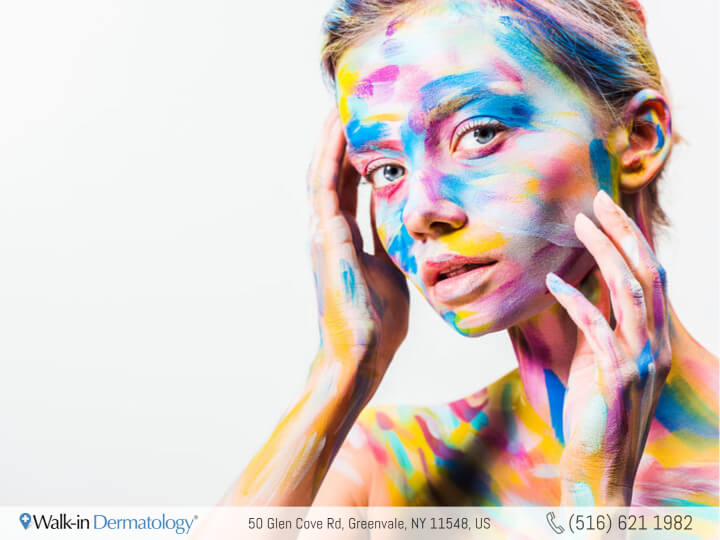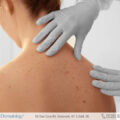Tues: 8:30am - 3:00pm
Wed: 12:00pm - 6:00pm
Thurs: 8:30am - 3:00pm
Fri: Closed
Sat: 8:30am - 12:30pm
Sun: Closed
Greenvale, NY 11548
Is Face Paint Bad for Your Skin?


Prolonged use of any type of body paint is not good for the skin, because the paint prevents your skin from breathing. Any type of paint pigment is going to cover the skin’s pores, which can create an environment for acne, rashes and blemishes.
While face painting might be fun at events such as music festivals and especially for children enjoying a fair or carnival, it’s important to avoid decorating your face or body with products that aren’t intended for use on your skin. It’s an invitation to severe rashes, allergic reactions and worse.
The problem with paying for face painting at special events is you really have no idea where the paint comes from or what it contains. The Breast Cancer Prevention Partners and its Campaign for Safe Cosmetics in a recent study found that more than 50 percent of face paints and cosmetics (lip balms, nail polish and makeup kits marketed to kids) contain at least one ingredient or contaminant with a proven connection to hormone disruption, developmental toxicity, learning difficulties and even cancer. So when using these products it comes down to a coin toss over whether you’re putting something potentially harmful on your skin.
For those reasons alone, it’s a good idea to avoid face paint when you don’t know the source and do not have access to the list of ingredients the pigments contain. And you should never apply paint to your face that isn’t specifically labeled for use as face paint.
Even when you buy a face painting product that lists all the ingredients, you still don’t know how you or your child will react if you’ve never used it before. It’s a good idea to test the product before applying paint on your face. Apply a small patch of paint to your forearm and let it remain for about a day to see if it causes any adverse reaction. This is particularly important if you have sensitive skin.
If the product doesn’t cause any irritation, it may be okay for face painting, but you should still try to use as little paint as possible. Applied too thick, even paints labeled for skin use can irritate your face and eyes if you use too much.
One trick to protect your skin and help make the paint easier to come off later is to apply a light coat of lotion and let it dry before painting your skin.
If you’re hitting Coachella, Burning Man or some similar event where it seems like a fun idea to paint your entire body, be extremely careful while outdoors. The paint blocks pores in your skin, preventing you from perspiring. This is the body’s natural way of cooling down. If your skin is unable to sweat, you’re at heightened risk of heat stroke.
Face Paint Removal Tips & Techniques
At the end of the day, when it’s time for bed, remove all paint just as you would take off makeup. Wearing face paint too long can cause skin irritation no matter how non-toxic the product is promoted to be. While you sleep and turn over in bed, the paint can also smear across your face and get into your eyes, nose and mouth. If that’s not enough, think of your sheets.
The most important thing you can do is follow the product directions for removing the paint. Most face paint will come off with mild soap and a washcloth dipped in warm water. To remove all the paint, especially when cleaning up young children, use high-quality baby wipes to get at all the little crevices around the nose and eyes. The cheap baby wipes should be avoided because they use lower quality ingredients that can irritate the facial skin on young children. Vaseline and baby oil can speed up the process of paint removal. Baby lotion also works. Cold cream and makeup remover will get rid face paint, but these products tend to be much more expensive than baby oil.
If you get home one night to discover you have none of these cleansing products to take off face paint, don’t panic. Hit the pantry for a bottle of olive oil. Daub cotton swabs or a balled-up tissue in the oil and use these improvised tools to take off the paint.
If you do experience a bad reaction to face paint, do not apply anything to the affected area except a washcloth dipped in cool water, which can offer some relief. Then set up an appointment with a dermatologist right away.
Most people are unlikely to need or want face paint more than 2 to 3 times per year unless they happen to be starring in a Broadway revival of Cats. More likely, face paint comes into play around Halloween, summer fairs and carnivals, and big outdoor music events. Occasional face painting, when practiced safely, may cause no more harm than fleeting acne or mild skin irritation. But just to be safe, always test the paint on your forearm or lower leg if you’re trying out a new product.
Getting the Best Treatment
If you or a family member have an adverse reaction to face paint or makeup, whether it’s skin irritation, an allergy, rash or some other concern, you don’t have to wait to see a board-certified dermatologist.
Throughout New York and many parts of the country, patients might have to wait weeks before they can see a board-certified dermatologist and get a diagnosis, much less actual treatment.
At Walk-in Dermatology you can be seen today either in-person at one of our clinics or through a Video Visit from the comfort of your own home.
Read more: What Do the Early Stages of Skin Cancer Look Like?








